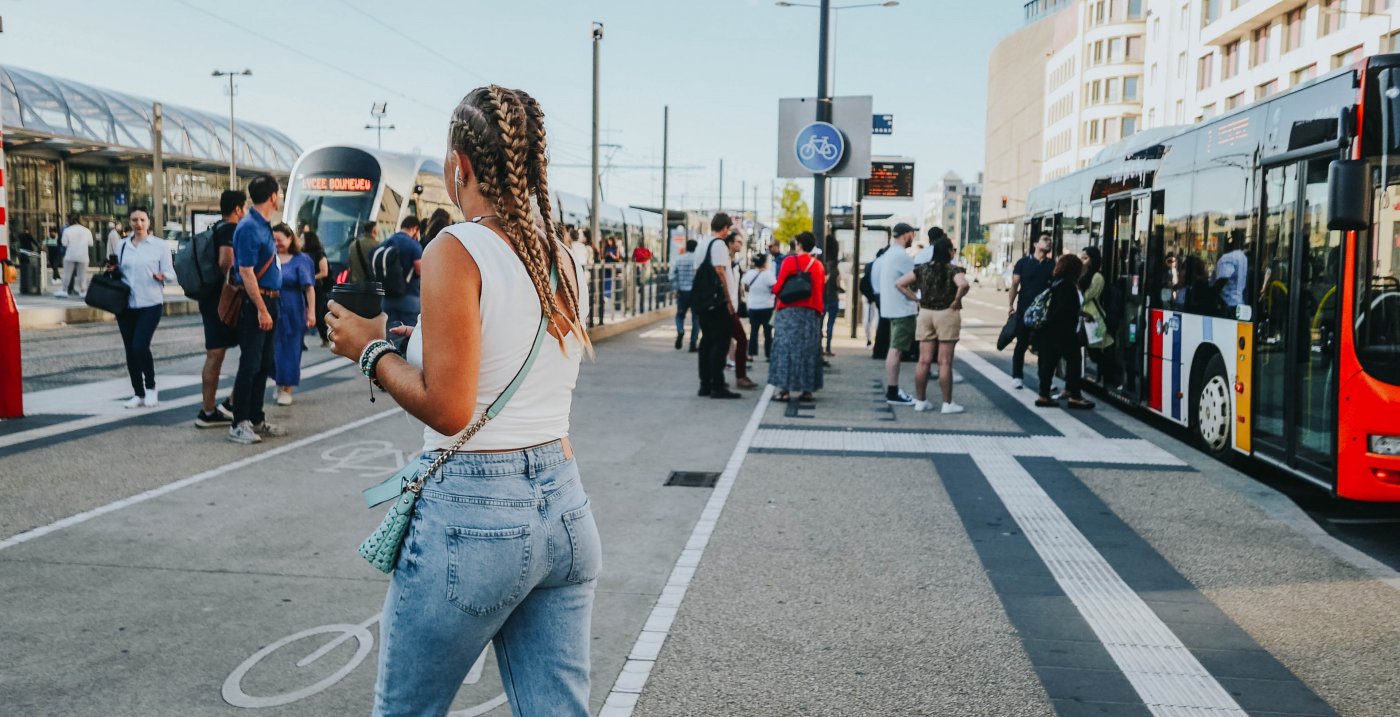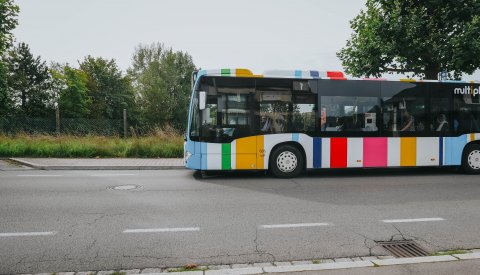Before your bus journey
Can children travel unaccompanied?
Children under 4 must be accompanied by someone aged 12 or over.
Are animals allowed on the bus?
You can bring your pet on the bus only if it can be kept on your lap without inconveniencing other passengers.
Animals that, because of their size, cannot be held on one's lap must be kept on the floor on a leash.
Dogs that might bother or pose a danger to surrounding passengers must be muzzled.
Animals travel free of charge.
Are bicycles allowed on the bus?
You can bring your bike on the bus free of charge as long as there is enough space and it does not inconvenience other travellers.
However, we reserve the right for our bus drivers and security personnel to refuse to allow bikes on the bus in any given situation. Cyclists are never given priority over other travellers.
Mopeds, motorcycles, etc. are not allowed on public transport.
Am I allowed to board buses with bulky items?
You are allowed to bring items with you on the bus that are easy to carry (such as hand-held parcels), provided this does not violate tax, police or administrative regulations.
I am waiting at the bus stop, but the bus does not stop...
If the bus does not stop at your stop, it is probably full. For safety reasons, if the bus is already full, no more passengers may be allowed on the bus. If this is the case, the driver must continue along the usual route and serve only the stops where passengers wish to get off.
The bus I take to work is often late...
During peak hours, both buses and other road users may experience congestion issues affecting the flow of travel in the city.
Especially outside of school holidays, buses may unfortunately be delayed during rush hour.
To view bus departures on your smartphone in real time, download the City of Luxembourg's free app, cityapp – VDL.
Bus departure times
I am waiting for a bus at my stop. How can I find out how long I will need to wait?
Bus stops may be equipped with:
- an LED electronic display panel with 4 or 8 lines of text;
- a TFT display screen mounted on the shelter;
- a "< a
- href="https://www.vdl.lu/en/getting-around/bus/routes-and-maps/pilot-project-live-paper">Live-Paper" display, which replaces the traditional paper timetables.
Bus departures – and in some cases, network traffic information – are displayed in real time on all of these media.
For stops that are not equipped with one of these devices, bus departures can be viewed by using a smartphone to scan the QR code displayed on the paper timetable. On scanning the QR code, the user will be directed to the stop's internet page.
What does the information displayed on the various media mean?
The electronic display panel will show:
- the bus line number;
- its final destination;
- upcoming departures (as a countdown in minutes, or the official schedule); and
- the platform number from which the bus will depart (where applicable).
What do the different symbols mean, and can I use them to find out if my bus is late?
Bus pictogram
A simple "bus" pictogram means that the bus is currently at, or is approaching, the stop.
Flashing bus pictogram
If the pictogram is flashing, this means that the bus is about to depart or has just departed.
Pictogram with several vehicles
A pictogram with several vehicles indicates that the bus is temporarily stuck in traffic between two stops, for example in the event of a traffic jam or accident. If this is the case, it is impossible to estimate when the bus will arrive.
What does "real-time departures" mean?
The electronic display panels show the actual waiting time before the departure of your bus. This is an estimate that is calculated by the City's operations support system, known as the "ITCS" (Intermodal Transport Control System). As the ICTS can track buses, it can calculate delays with respect to scheduled departure times.
What does "official schedule" mean?
This is the schedule of theoretical departure times as displayed at bus stops, published in leaflets or available in PDF format at (bus.vdl.lu). The official timetable is also displayed on electronic media if a bus cannot be located due to a technical failure, or if the bus in question is not equipped with the ICTS.
More information on real-time departures can be found in the answer to the question above.
Why are departure times sometimes counted in minutes (e.g. 14') and at other times displayed as a specific time (e.g. 11:59)?
The electronic display panels show the actual waiting time before the departure of your bus. This is calculated by the City's operations support system, known as the "ITCS" (Intermodal Transport Control System). As the ICTS can track buses, it can calculate delays with respect to scheduled departure times.
14 min.
Waiting time, displayed as a countdown in minutes. As the bus tracking system can calculate delays with respect to scheduled departure times, the electronic display panels show an estimate of the actual waiting time before the departure of your bus.
11:59
The departure time is displayed as the scheduled time in the following cases:
- for buses not equipped with the tracking system;
- for buses whose equipment is temporarily unresponsive;
- when a bus is scheduled to depart in more than 14 minutes , for LED display panels with 4 or 8 lines of text, or in more than 2 hours, for bus-shelter TFT screens and "Live-paper" displays;
- when a bus without an on-board ITCS is re-routed.
N.B.
As the system does not have real-time information for these routes, it can only display the departure times listed in the official schedule. This is why the information disappears from the sign after the time displayed, regardless of whether the bus has arrived at the stop.
How does the system know when the bus will arrive?
The information displayed on the screens comes from the ITCS (Intermodal Transport Control System), which is a bus tracking system that can calculate delays with respect to scheduled departure times and provide an estimate of the waiting time. As the displayed waiting time is an estimate, it may not correspond to the actual waiting time. The central ITCS sends estimated times to the various displays across Luxembourg City via data interfaces that communicate in real time.
Are all City of Luxembourg buses equipped with the ITCS?
Yes, all buses operated by the City of Luxembourg and its contractors are in principle equipped with the ITCS and can therefore be tracked.
However, some privately operated buses are not yet equipped with the system and therefore cannot be tracked. For these buses, departures are posted according to the official schedule.
What does the scrolling text on the display mean?
Display panels and screens can also show network traffic information, for example, when buses are diverted or a stop is closed.
The same information can be viewed by tapping the News button on "Live-Paper" displays.
- Group travel
Is it permitted to use public transport for group travel?
Yes, groups can use the City's municipal bus lines to get around. However, in order to avoid any disruptions to service and ensure the safety of all passengers, we ask that group travel be limited to a maximum of 20 people.
What should we do if our group is larger than 20 people?
If the number of people in your group exceeds 20, we ask that you split up into several smaller groups of no more than 20 people. These smaller groups may then take separate buses – at different times as may be the case – in order to avoid putting too much pressure on public transport all at once.
Why the 20-person limit per group?
This limit is designed to keep buses running smoothly, avoid overcrowding, and ensure a pleasant and safe journey for all. As the buses are open to everyone, it is important that large groups take care not to block acccess for other passengers, ensuring they can embark and disembark easily.
Do you need to need to make a special request for school or extracurricular group travel?
No, you no longer need to make a special request for school or extracurricular travel. To simplify and optimise service for all passengers, we ask that groups, including school groups, comply with the 20-person limit and split up into smaller groups if necessary.
During the Walking Bus journey
What rules apply for getting on/off buses, and where is this allowed?
When trying to get on and off the bus: please be aware that according to the traffic code, bus drivers are prohibited from letting passengers on or off anywhere other than at marked bus stops and bus stations. As a passenger, you are also prohibited from getting on or off a bus anywhere other than at bus stops and stations.
This means that if you miss your stop, the driver cannot let you out before the bus arrives at the next stop. They can, however, tell you how to reach your stop, either by getting out at the next stop or by staying on the bus until it comes back to your stop.
I have reduced mobility. What are some tips I can follow?
If you have reduced mobility, it is important to:
- be seated when the bus starts to move;
- press the stop request button in good time;
- wait for the vehicle to stop before leaving your seat to get off the bus.
When you get on the bus, do not hesitate to ask the driver to wait until you are seated before driving on, or even specify the stop where you want to get off.
The bus is full: can I stand at the front next to the driver?
By law, the area near the driver may not be occupied by passengers while the bus is in motion. Every bus is fitted with a barrier that separates the driver's area from the passenger area of the bus: this is a safety measure to ensure that the driver always has enough room to manoeuvre and that their driving is not impaired if the bus is crowded or has to brake suddenly.
For understandable visibility and safety reasons, drivers are instructed not to allow passengers to stand in this front area. The driver will ask people who remain in this area to step back behind the safety barrier or get off and take the next bus.
Traffic has come to a halt: can I get off the bus?
According to the traffic code and for obvious safety reasons, bus drivers are prohibited from letting passengers on or off anywhere other than at marked bus stops and bus stations.
You therefore may not get out while the bus is in a traffic jam, even if it is stopped at a red light or next to the pavement.
Who announces the names of the bus stops?
In 2015, the City of Luxembourg launched the participatory project "Votre voix dans les bus de la Ville" (Your Voice on our City Buses), following the example of other cities around the world, where similar schemes have met with great success. Different people have lent their voices to be used to announce bus stops throughout the capital. The choice of voices recorded was made according to certain criteria (age, sex, etc.) to reflect the multiplicity and diversity of the City.
After your bus journey
I forgot my umbrella on the bus. What should I do?
If you realise that you have left or lost an item on one of our buses, please call the Service Autobus (Bus Department) as soon as possible on 4796-2975.
To make it easier for us to look for your lost property, please tell us as best you can the date, time and line number of the bus on which you left your item.
Lost and unclaimed objects will be returned to the National Lost Property Office (Service national des objets trouvés) of the Grand Ducal Police (244 244 070).
Please give any items you find on a municipal bus to the driver.
How do I lodge a complaint or make a suggestion?
For any queries, suggestions or complaints regarding our bus service, please get in touch by filling in our Service Autobus contact form.
When submitting the form, please provide as many details as possible (date, time, line, direction, stop, bus number, etc.) so that we can identify the bus or journey in question.
Report a problem!
If you notice damage to a station or stop (such as a torn schedule), please let us know through our "Report-It" service or contact form.














